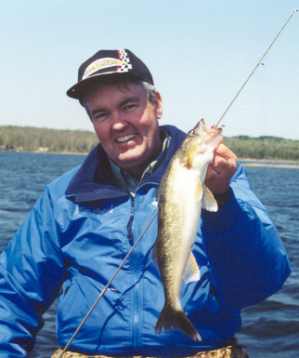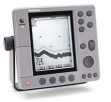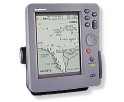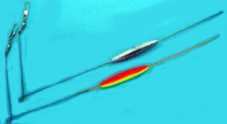



















|
Secret to Summer Walleyes
By Ron Anlauf e-mail
ranlauf@ecenet.com

Ron Anlauf the author shows
off a nice summer walleye
|
Summer walleye fishing can be a little tough, but it doesn’t have to
be that way. The key is understanding how warming water temperatures and
a changing environment can effect walleye location, and activity levels.
A walleye’s environment is one that is constantly changing, with walleyes
reacting accordingly. To stay with the fish, anglers need to be willing
to change how and where they fish for walleyes, and keep an open
mind. Doing the same things in the same places, time after time, will probably
yield less than satisfactory results. As walleyes vacate early season
hideouts, in favor of deeper summer haunts, there’s a period of time
when fish are in transition. |
When there aren’t that many fish shallow, and there aren’t that many deep,
fishing can be a bit sporadic. However, as more and more fish show
up at their new “home for the summer“, the action can only get better.
With an increase in numbers, your chances for finding a few active ones
greatly increases. Walleyes don’t all do the same thing at the same
time, and when it comes to feeding movements, it’s like they take
turns. Some will be totally inactive, some may be starting to stir a little
but won’t move far to take a bait, and others may be extremely aggressive
and willing to take just about anything you put in front of them.
Those are the traitors that can give up a schools identity, and location.
Summer location can include deep, offshore structure, like sunken islands,
bars and humps. Look for structures that have most of their mass
above the thermocline. Structure that is too deep will see little walleye
activity, if any, until after the fall turnover. Larger structures will
often out produce the smaller ones, simply because they can offer more
feeding opportunities for ‘eyes on the prowl. However smaller ones
can be easier to fish, because of their simplicity.

Ray
Marine L 750 |
There’s only so many places they can hide. You can quickly check the
top, sides, and the base of the break, with a good graph, like the
Raymarine
L750. The L750 provides incredible definition, and has a white line
feature that allows the user to identify fish that are holding tight to
the bottom. If they’re there, go ahead and fish, if not, it’s time to move
on. |
Larger structures will require you to spend more time watching your electronics,
and less time fishing. Walleyes can be anywhere, and it doesn’t pay to
fish where they’re not. To find them, you can save some time by cruising
the entire structure, making note of where you saw the largest concentrations.

Ray
Marine 425 GPS |
In that situation, a Global Positioning System can be a huge asset,
as concentrations can be marked with an icon, allowing you to return after
your search is completed. The Raymarine
425 is a GPS that possesses the new W.A.S.S. capabilities, and is accurate
to within nine feet, which can help get you back to an exact spot. |
I Another option is dropping a marker which can be a good idea, and will
help keep you oriented with the area you’re fishing. One of
the best places to start your search, is near a break line that drops quickly
into deeper water. The top of deep structure can play host to perch, baitfish,
insects and crayfish. Active walleyes will often be found cruising the
top edge of a break, where they can quickly move up to grab a bite to eat.
Another place to find summer ’eyes, that is often overlooked, is the transition
line where hard bottom meets soft. Where gravel or rock changes to
mud or silt, a transition line is created, and can concentrate fish.
Transition line fish see little attention by most anglers, and can be one
your best bets for a shot at a real hawg. Once you’ve found
a potential area, and have marked at least a few fish, it’s time to get
down to business. The early season presentations of rigging and jigging
may still produce, but quicker methods, like trolling spinners, really
start to pickup. Rising water temps can push a walleye’s metabolism to
the boiling point, and increase the chances that he’ll react to a
speedier technique.
|
|
One of the top summer producers, is a spinner and live bait combo.
Spinners possess an element of speed, and it’s the speed that can
often nail walleyes with a bad attitude. To get a spinner in the “zone”,
it’s hard to beat a spinner and bottom bouncer combination. A bouncer can
get a bait where you want it , and run relatively snag free. Bouncers
in the two to three ounce range are the ticket, and allow the user to keep
the bait close to the boat. By keeping it close, you can react to sudden
depth changes |
You can also lift the bait off the bottom, to get it in front of any high
riding fish that you mark on your depthfinder. If you see a fish
riding high of the bottom, try to lift the bait to the same level. Walleyes
tend to feed up, and by lifting your bait up, you increase the odds
that he’ll take your offering. You’ll want to keep the spinner snell
short, let’s say three feet or less. Longer snells allow for more
drop, and result in more snags. The odds on favorite bait for dressing
a spinner rig, is a big fat juicy night crawler. However leeches
can be effective at times, and minnows can turn late summer ’eyes when
nothing else will. One thing to keep in mind in your quest for mid
summer ’eyes, is the fact that walleyes continue to feed, and do
so more heavily than at any other time of the year. The key is to find
them, and then find out what they want. Quite often, what they want
is something with a little speed. Think about it, not only does a walleye’s
metabolism increase, but so does it’s prey. Everything is moving at a faster
pace, and it’s a fast paced world we’re living in. See you on the
water.
Ron Anlauf e-mail
ranlauf@ecenet.com

Walleyes Inc. website is maintained
by Randy
Tyler Fishing the In-Fisherman Professional Walleye Circuit, Masters
Walleye Circuit and the Team Walleye Circuit. All rights reserved.Copyright
1999/2001
Please visit these site sponsors
Daiichi/Tru-Turn Hooks,
Lindy
Little Joe,
R-A.M Mounting Systems,
Ranger
boats,
Mercury Marine, Bedford
Sales , Hamby's Beaching Bumpers,
Goldeneye
Marine products, Panther
Marine Products, Webfoots body
sock, Bait Rigs Tackle
|





